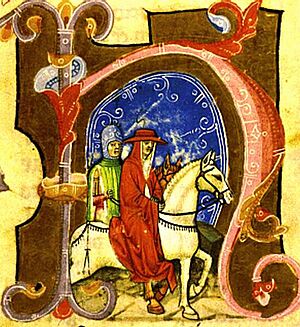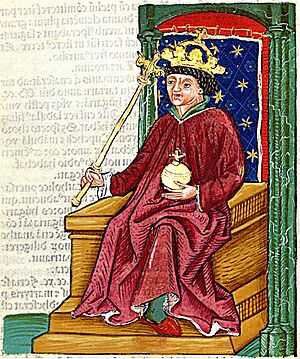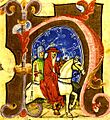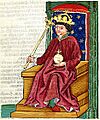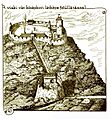Lodomer facts for kids
Quick facts for kids Lodomer |
|
|---|---|
| Archbishop of Esztergom | |
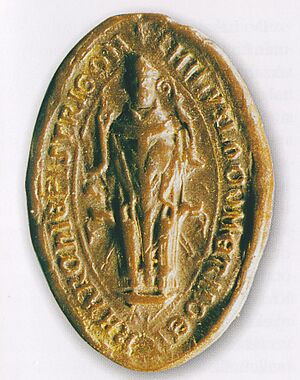
Seal of Archbishop Lodomer, 1291
|
|
| Enthroned | 13 June 1279 |
| Reign ended | 2 January 1298 |
| Predecessor | Nicholas Kán |
| Successor | Gregory Bicskei |
| Other posts | Bishop of Várad |
| Personal details | |
| Died | 2 January 1298 |
| Nationality | Hungarian |
| Denomination | Roman Catholic |
Lodomer (Hungarian: Lodomér; died 2 January 1298) was an important church leader in the Kingdom of Hungary in the late 1200s. He served as the Bishop of Várad (now Oradea in Romania) from 1268 to 1279. Later, he became the Archbishop of Esztergom, a very high position, from 1279 until his death.
Lodomer was a strong opponent of Ladislaus IV of Hungary. He even excommunicated the king for not making the Cumans (a nomadic group) follow Christian ways. After Ladislaus died, Lodomer strongly supported the new king, Andrew III of Hungary. He helped Andrew try to make the king's power strong again against powerful lords who were causing trouble.
Contents
Early Life and Education
Lodomer was likely born in the 1230s, around the time of the first Mongol invasion in Hungary. He had a sister whose son, Thomas, also became an Archbishop of Esztergom later on. Lodomer helped his nephew study at the University of Padua in Italy.
Historians have debated where Lodomer's family came from. Some thought he might have been from the Kievan Rus' area. However, later research showed this was probably not true. It is now believed he might have been related to the Vázsony family.
Lodomer is first mentioned in records between 1257 and 1261. At that time, he was a cantor (a church singer and leader) in the church of Veszprém. He was in charge of managing the cathedral school there. He also taught priests and poor students.
Lodomer was called a magister (a master) by the late 1250s. This means he had already learned a lot about church law. He then disappeared from records for about three years. Many historians believe he spent this time studying canon law (church law) and Roman law at the University of Bologna in Italy. His letters show he was very educated.
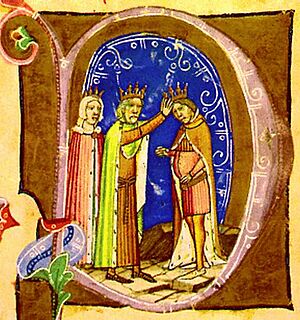
After his studies, Lodomer returned to Hungary. He worked for Duke Stephen (who later became King Stephen V) from 1264 to 1266. Stephen was having conflicts with his father, King Béla IV. Lodomer stayed loyal to Stephen during this civil war. He tried to help both sides make peace.
Bishop of Várad
Lodomer became the Bishop of Várad (today Oradea, Romania) by November 1268. The Pope himself confirmed his appointment. Várad was in the area ruled by Duke Stephen at the time.
When Stephen V became king in 1270, he gave special benefits to the Diocese of Várad. He allowed the church to use mines freely and receive lands from noble families who had no heirs. Lodomer worked hard to rebuild the diocese. It had been badly damaged during the Mongol invasion years before. He started monasteries and church schools.
Lodomer was part of the king's council during Stephen V's short rule.
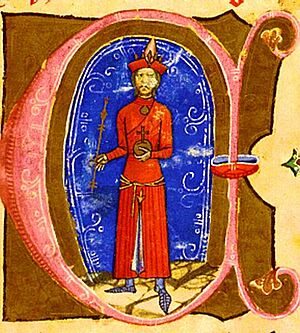
When Stephen V died in 1272, his young son, Ladislaus IV, became king. This started a time of great trouble in Hungary. Two groups of powerful lords fought for control. Lodomer initially supported the young king, hoping to keep the royal power strong.
In 1277, Lodomer attended a big meeting in Rákos. There, the 15-year-old King Ladislaus was declared old enough to rule. He was given power to bring peace back to the country. Lodomer also went on a diplomatic mission to Vienna to make an alliance with Rudolf I of Germany. This alliance was against Ottokar II of Bohemia.
Lodomer's influence with the Pope grew in the late 1270s. Pope Innocent V asked him to lead a church committee. This committee investigated the life of Princess Margaret, daughter of Béla IV. They looked into miracles attributed to her. Margaret was later declared a saint (beatified).
The position of Archbishop of Esztergom had been empty since 1272. After another archbishop died in 1278, Lodomer became the most important church leader in Hungary. This was because of his strong connections in Rome and his great education. The Pope eventually appointed Lodomer as the new Archbishop of Esztergom on June 13, 1279.
Archbishop of Esztergom
Conflict with King Ladislaus IV
A special envoy from the Pope, Bishop Philip of Fermo, arrived in Hungary in 1279. He found that many Cumans in Hungary were still following their old pagan customs. He made the Cuman leaders promise to become Christian. He also made King Ladislaus swear to make sure they kept their promise.
However, the Cumans did not follow the new laws. King Ladislaus, who was half-Cuman himself, did not force them. Because of this, Bishop Philip excommunicated King Ladislaus. This meant the king was cut off from the Church. Philip also placed Hungary under an interdict, which stopped many church services.
Lodomer and other bishops initially supported the papal envoy. But when the Cumans captured Bishop Philip, Lodomer and the bishops turned against the king. They wanted the Church to be free from royal control. Soon, King Ladislaus was also captured. Lodomer helped negotiate their release. Ladislaus then promised again to enforce the Cuman laws.
After Bishop Philip left Hungary in 1281, Lodomer tried to bring peace back to the country. He offered the Church's support to King Ladislaus. He also asked the Pope to undo some of Bishop Philip's strict decisions. Lodomer even recognized the king's right to appoint church leaders.
Lodomer hoped the king would return to Christian ways. This hope grew when Ladislaus defeated a Cuman army in 1282. The Pope praised Lodomer's efforts to reconcile the king and the Church. However, Lodomer's efforts failed by late 1283. King Ladislaus could not defeat the powerful Kőszegi family. The king also left his wife and lived among the Cumans.
When the Mongols invaded in 1285–86, many people blamed Ladislaus. He had even used Mongol prisoners in his army.
Lodomer tried to help Ladislaus make peace with the Kőszegi family in 1286. But the king later removed the Kőszegi family from his royal council. Lodomer completely gave up on the king when Ladislaus imprisoned his own wife and gave her money to his Cuman mistress.
Lodomer planned to declare a crusade against the king and the Cumans. But the Pope died, stopping this plan. In 1287, Lodomer freed Queen Isabella from her captivity. She then moved to Esztergom under Lodomer's protection. Lodomer then called a meeting and excommunicated King Ladislaus.
The king was very angry. He reportedly threatened to destroy the Church with "Tartar swords." In January 1288, the powerful lords captured Ladislaus. He was soon freed, but he agreed to make a deal with Lodomer. Lodomer absolved the king (removed the excommunication) on the condition that Ladislaus would live as a good Christian.
However, Ladislaus broke his promise. He imprisoned opposing lords and even abducted his own sister, a nun, to marry her off. Lodomer wrote a letter to Pope Nicholas IV in May 1288. He listed all the king's wrongdoings and the chaos in the kingdom. These letters are very important historical documents.
Lodomer and other archbishops made agreements with the powerful lords. King Ladislaus lost all his power and influence. Lodomer even asked an Augustinian monk to write a story about Stephen I of Hungary. This was to remind people of the importance of a Christian king.
Lodomer urged the Pope to declare a crusade against Ladislaus. With Lodomer's agreement, the Kőszegi family offered the crown to Andrew the Venetian, a distant relative of the king. Andrew arrived in Hungary in early 1290. On July 10, 1290, King Ladislaus was murdered by three Cumans. It is believed Lodomer was not involved in planning the murder.
Supporting King Andrew III
After Ladislaus's death, Lodomer quickly sent monks to inform Andrew of the news. Andrew escaped from prison and hurried to Hungary. Archbishop Lodomer crowned Andrew III king on July 23, 1290. The lords and church leaders swore loyalty to Andrew. But only after he promised to bring peace and respect their rights. Lodomer himself wrote this important document.
Lodomer and the church leaders became Andrew's strongest supporters. They wanted to make the king's power strong again and end the chaos. They also wanted to keep the Pope and the Holy Roman Empire from interfering too much. Lodomer, who had once supported the Pope's involvement, now protected Hungary's independence.
In 1291, Andrew III invaded Austria. Lodomer helped negotiate the Peace of Hainburg treaty. This treaty ended the war and ordered the destruction of fortresses that Austria had taken from the Kőszegi family. The treaty's language showed Lodomer's ideas about a good Christian ruler.
However, the Kőszegi family rebelled against Andrew in 1292. They supported Charles Martel as king, who was also supported by the Pope. Lodomer excommunicated Ivan Kőszegi, showing his opposition to the Pope's choice. Andrew's troops put down the rebellion. But the Kőszegi family later captured Andrew himself. He was freed after four months.
Despite Lodomer's efforts, Hungary remained in chaos. Powerful families like the Kőszegis and Csáks ruled their own areas. They rebelled against Andrew almost every year in the late 1290s. In 1296, Andrew declared war on the Kőszegi brothers again. Archbishop Lodomer again excommunicated them. Lodomer even joined the military campaign with his own troops. But they could not fully defeat the rebellious lords.
Lodomer held several important church meetings (synods) during his time as archbishop. He also helped various religious orders. For example, he approved the rules for the Order of Saint Paul the First Hermit around 1297.
Church Properties and Conflicts

During Lodomer's time, the Archdiocese of Esztergom received many land donations. King Ladislaus IV gave lands to the Church. He also allowed nobles who died without heirs to leave their wealth to the Esztergom Basilica. The king also gave the archdiocese special rights, like exemption from mining taxes.
However, the archdiocese also faced many challenges. Powerful neighboring lords often attacked and stole from church lands. For example, Thomas Hont-Pázmány caused a lot of damage by plundering church estates. Lodomer had to settle for a small compensation.
Lodomer worked to expand the Church's lands around Esztergom. He often exchanged properties to create larger, more connected areas. This helped protect the archdiocese's interests against powerful lords. He also acquired castles like Visk as compensation for damages.
Lodomer was the first archbishop to create a special group of loyal followers, called an ecclesiastical familia. These were church nobles and soldiers who helped him exercise his military and political influence. Their lands were strategically located to defend against attacks from powerful lords like Matthew III Csák.
Lodomer spent his last months in Monoszló and Budafelhévíz. He held his last church meeting in December 1297. He died on January 2, 1298. After his death, the balance between King Andrew III and the church leaders changed.
Images for kids


